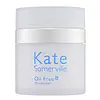What's inside
What's inside
 Key Ingredients
Key Ingredients

No key ingredients
 Benefits
Benefits

 Concerns
Concerns

 Ingredients Side-by-side
Ingredients Side-by-side

Water
Skin ConditioningIsocetyl Stearate
EmollientPentaerythrityl Tetracaprylate/Tetracaprate
EmollientC12-15 Alkyl Benzoate
AntimicrobialPolyamide-5
Skin ConditioningXylitylglucoside
HumectantAnhydroxylitol
HumectantXylitol
HumectantDipalmitoyl Hydroxyproline
Skin ConditioningPEG/PPG-18/18 Dimethicone
EmulsifyingBehenyl Alcohol
EmollientPullulan
Cetearyl Ethylhexanoate
EmollientSodium Polyacrylate
AbsorbentDimethicone
EmollientCyclopentasiloxane
EmollientButylene Glycol
HumectantTrideceth-6
EmulsifyingAlgae Extract
EmollientTriethanolamine
BufferingAhnfeltiopsis Concinna Extract
Skin ConditioningEthylhexylglycerin
Skin ConditioningPhenoxyethanol
PreservativeAdenosine
Skin ConditioningWater, Isocetyl Stearate, Pentaerythrityl Tetracaprylate/Tetracaprate, C12-15 Alkyl Benzoate, Polyamide-5, Xylitylglucoside, Anhydroxylitol, Xylitol, Dipalmitoyl Hydroxyproline, PEG/PPG-18/18 Dimethicone, Behenyl Alcohol, Pullulan, Cetearyl Ethylhexanoate, Sodium Polyacrylate, Dimethicone, Cyclopentasiloxane, Butylene Glycol, Trideceth-6, Algae Extract, Triethanolamine, Ahnfeltiopsis Concinna Extract, Ethylhexylglycerin, Phenoxyethanol, Adenosine
Water
Skin ConditioningCetyl Ethylhexanoate
EmollientSorbitan Stearate
EmulsifyingMethyl Gluceth-20
HumectantPolysorbate 60
EmulsifyingDimethicone
EmollientTocopherol
AntioxidantTocopheryl Acetate
AntioxidantTetrahexyldecyl Ascorbate
AntioxidantPanthenol
Skin ConditioningSodium Hyaluronate
HumectantCetearyl Alcohol
EmollientCeteareth-20
CleansingAminomethyl Propanol
BufferingCarbomer
Emulsion StabilisingDisodium EDTA
Phenoxyethanol
PreservativeEthylhexylglycerin
Skin ConditioningPotassium Sorbate
PreservativeWater, Cetyl Ethylhexanoate, Sorbitan Stearate, Methyl Gluceth-20, Polysorbate 60, Dimethicone, Tocopherol, Tocopheryl Acetate, Tetrahexyldecyl Ascorbate, Panthenol, Sodium Hyaluronate, Cetearyl Alcohol, Ceteareth-20, Aminomethyl Propanol, Carbomer, Disodium EDTA, Phenoxyethanol, Ethylhexylglycerin, Potassium Sorbate
Ingredients Explained
These ingredients are found in both products.
Ingredients higher up in an ingredient list are typically present in a larger amount.
Dimethicone is a type of synthetic silicone created from natural materials such as quartz.
What it does:
Dimethicone comes in different viscosities:
Depending on the viscosity, dimethicone has different properties.
Ingredients lists don't always show which type is used, so we recommend reaching out to the brand if you have questions about the viscosity.
This ingredient is unlikely to cause irritation because it does not get absorbed into skin. However, people with silicone allergies should be careful about using this ingredient.
Note: Dimethicone may contribute to pilling. This is because it is not oil or water soluble, so pilling may occur when layered with products. When mixed with heavy oils in a formula, the outcome is also quite greasy.
Learn more about DimethiconeEthylhexylglycerin (we can't pronounce this either) is commonly used as a preservative and skin softener. It is derived from glyceryl.
You might see Ethylhexylglycerin often paired with other preservatives such as phenoxyethanol. Ethylhexylglycerin has been found to increase the effectiveness of these other preservatives.
Phenoxyethanol is a preservative that has germicide, antimicrobial, and aromatic properties. Studies show that phenoxyethanol can prevent microbial growth. By itself, it has a scent that is similar to that of a rose.
It's often used in formulations along with Caprylyl Glycol to preserve the shelf life of products.
Water. It's the most common cosmetic ingredient of all. You'll usually see it at the top of ingredient lists, meaning that it makes up the largest part of the product.
So why is it so popular? Water most often acts as a solvent - this means that it helps dissolve other ingredients into the formulation.
You'll also recognize water as that liquid we all need to stay alive. If you see this, drink a glass of water. Stay hydrated!
Learn more about Water